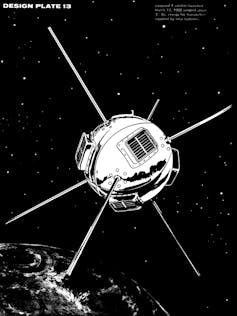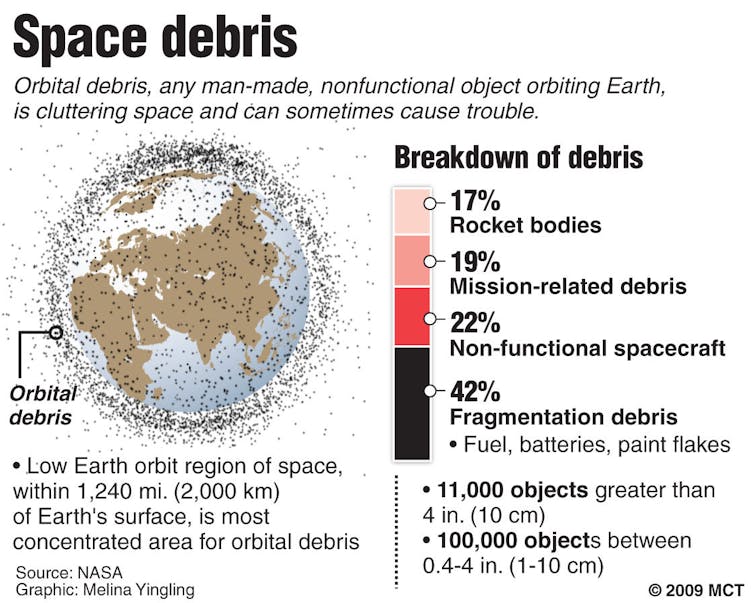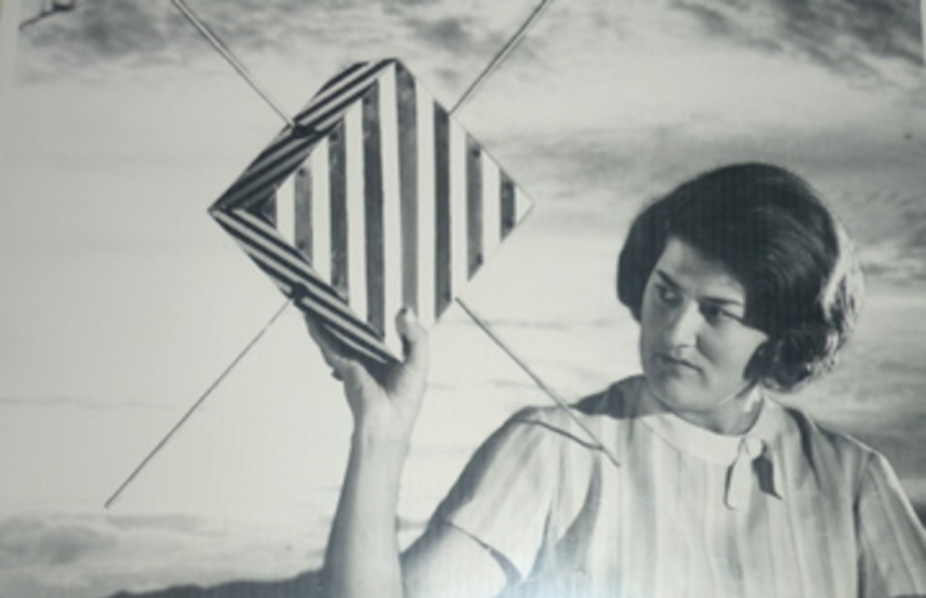A few weeks ago astronauts on the International Space Station hid in escape capsules following concerns a piece of space junk was going to collide with the station.
The collision didn’t eventuate but the fact remains – space junk is a very serious problem in (and outside) our space-reliant world.
A collision with debris could cause functioning satellites to explode or fail. If we want to keep on using the telecommunication, Earth-observation and navigation services we can scarcely do without these days, that problem needs to be solved.
Indeed, we’ve seen many proposals to clean up the mess, including space-janitor satellites and even giant lasers.
But is the problem as straightforward as just doing some orbital garbage disposal? What about the historic spacecraft in orbit that represent our incredible technological and social journey into space?

Cultural heritage comprises the objects, places and practices from the past that people think are important in the present and want to preserve for the future. It’s about community identity and well-being; feeling connected in an age of globalisation and social fragmentation.
Such desires are supported by the work of the United Nations Educational, Scientific and Cultural Organization (UNESCO).
So far, the existence of cultural heritage values for the stuff we now call “space junk” has barely been considered. But when you think about it, some of the artefacts that hurtle through space, far above our heads, are among the most significant in human history.
Those artefacts represent the technologies and trajectories that shaped the world we live in, the era in which humanity truly became spacefaring.
Heritage management is now a routine part of any terrestrial industry or development, and the space industry should be no different. This doesn’t have to mean compromising mission safety or the space environment – we just need to plan for the removal of “space junk” in the right way.

One of the most significant pieces of “space junk” is the US satellite Vanguard 1. Launched in 1958, this satellite is now the oldest human-made object in space.
One of the reasons for the launch of Vanguard 1 was to demonstrate the peaceful and scientific uses of space, in the days before there were any international treaties.
Historians argue that the infrastructure set up for Vanguard 1 – including tracking stations in Australia – shaped all subsequent US space programs. That’s a lot of cultural significance packed into an aluminium sphere the size of a grapefruit (as USSR leader Nikita Khrushchev disparagingly called it).
Vanguard 1 is also the only object that can tell us how human materials hold up in the space environment for that long.
(Constant exposure to cosmic rays, atomic oxygen, meteoroids, space junk and charged clouds of ionised atoms called plasmas creates stresses on the materials spacecraft are built from. This can cause them to weaken and erode - creating more pieces of junk in the process.
Despite experiments such as the Long Duration Exposure Facility and the Materials International Space Station Experiment, there is still so much we don’t know about long term exposure to the space environment).
Space heritage isn’t all about the superpowers, though. In 1970, a small striped box representing the ambitions and dreams of a bunch of Melbourne University students was launched into low-earth orbit, piggybacked on a NASA rocket.
The students had designed the satellite – dubbed Australis Oscar V – and constructed it from begged, borrowed and scrounged components. They then coordinated amateur radio enthusiasts across the world to collect data from the satellite. Australis Oscar V transmitted data for six epic weeks until its batteries died.
(It’s worth remembering that sometimes the only thing separating a satellite from space junk is a few weeks and a functioning battery.)
Part of what makes these satellites significant is that they are still up there. Do we really want to send them back into the atmosphere, or remove them from their original orbit, if we don’t have to?
The best way to approach this is not to look just at the amount of debris in orbit, but at the risk instead: just how likely is a collision with “space junk”?
Most of the “space junk” in Earth orbit is actually very tiny – millions of fragments less than a centimetre in size. Collisions with the small stuff happen constantly but they don’t generally cause mission failure or explosion.

The middle-sized stuff (1-10cm across) is more of a problem: there’s a high likelihood of collision, and the damage caused will be greater. However, whole spacecraft are numerically in the minority so while a collision would be catastrophic, it’s much less likely to happen.
The risk factors also depend on the orbit, as some orbits have a much higher density of debris than others. For instance, near-circular orbits below 2,000km, at around 20,000 km, and at 36,000km from Earth have the highest density of large debris over 10cm. The risks of collision will obviously be increased in these locations.
If we’re going to make decisions about what to destroy, let’s do it from an informed position. We need to know which objects do have cultural significance in orbit, from local, national and global perspectives. And we need to understand how their changing orbits may relate to collision risks.
Not all space junk was created equal; some bits are clearly more significant than others. No matter what kind of orbital debris removal scheme is implemented, it must be designed to avoid operational spacecraft anyway, so it’s a small leap to ensure precious artefacts are also preserved in their natural setting.
It’s still likely to be a while before we see large-scale space debris removal. We should use this time to plan a cultural heritage management strategy that will be both effective and practical.
Further reading:
- The archaeology of orbital space - Alice Gorman

